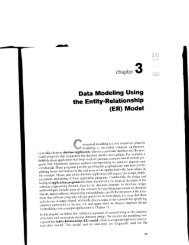13.1 through 13.5, 13.10 and 13.11
13.1 through 13.5, 13.10 and 13.11
13.1 through 13.5, 13.10 and 13.11
Create successful ePaper yourself
Turn your PDF publications into a flip-book with our unique Google optimized e-Paper software.
<strong>13.1</strong> Introduction!( ) frl \.i()tl t()\ \\'l)()icul.rrrd 16.phi'stnt-\'c,;l()r(ltecrittcclr colll-toragL-tl isks,.orage,ts Llsur<strong>and</strong>onclt ber f tl8€.rcl sec--' f vrr i-I lerarthere-rcnsivenlemrtlevelrk areir_'mory.ruvbackrt,l ter-tiary storage level, the hierarchy includes magnetic disks, as well as mass storage inthe form of CD-ROM (Compact Disk-Read-Only Memory) <strong>and</strong> DVD devices, <strong>and</strong>finally tapes at the least expensive end of the hierarchy. The storage capacity ismeasured in kilobytes (Kbyte or 1000 bytes), megabytes (MB or 1 million bytes),gigabytes (GB or I billion bytes), <strong>and</strong> even terabytes (1000 GB).Programs reside <strong>and</strong> execute in DRAM. Generally, large permanent databasesreside on secondary storage, <strong>and</strong> portions ofthe database are read into <strong>and</strong> writtenfrom buffers in main memory as needed. Now that personal computers <strong>and</strong> workstationshave hundreds of megabytes of data in DRAM, it is becoming possible toload a large part of the database into main memory. Eight to l6 GB of RAM or.r asingle server is becoming commonplace. In some cases, entire databases can bekept in main memory (with a backup copy on magnetic disk), leading to mainmemory databases; these are particularly useful in real-time applications thatrequire extremely fast response times. An example is telephone switching applications,which store databases that contain routing <strong>and</strong> line information in mainmemory.Between DRAM <strong>and</strong> magnetic disk storage, another form of memory, flash memory,is becoming common, particularly because it is nonvolatile. Flash memories arehigh-density, high-performance memories using EEPROM (Electrically ErasableProgrammable Read-Only Memory) technology. The advantage of flash memory isthe fast access speed; the disadvantage is that an entire block must be erased <strong>and</strong>written over simultaneously.z Flash memory cards are appearing as the data storagemedium in appliances with capacities ranging from a few megabytes to a few gigabytes.These are appearing in cameras, MP3 players, USB storage accessories, <strong>and</strong>so on.CD-ROM disks store data optically <strong>and</strong> are read by a laser. CD-ROMs contain prerecordeddata that cannot be overwritten. WORM (Write-Once-Read-Many) disks area form of optical storage used for archiving data; they allow data to be written once<strong>and</strong> read any number of times without the possibility of erasing. They hold abouthalf a gigabyte of data per disk <strong>and</strong> last much longer than magnetic disks.r Opticaljukebox memories use an array of CD-ROM platters, which are loaded onto driveson dem<strong>and</strong>. Although optical jukeboxes have capacities in the hundreds of gigabytes,their retrieval times are in the hundreds of milliseconds, quite a bit slower than magneticdisks. This type of storage is continuing to decline because of the rapid decreasein cost <strong>and</strong> increase in capacities of magnetic disks. The DVD (Digital Video Disk) isa recent st<strong>and</strong>ard for optical disks allowing 4.5 to 15 GB of storage per disk. Mostpersonal computer disk drives now read CD-ROM <strong>and</strong> DVD disks.Finally, magnetic tapes are used for archiving <strong>and</strong> backup storage of data. Tapejukeboxes-which contain a bank of tapes that are catalogued <strong>and</strong> can be automat-2, For example, the INTEL DD2BF032SA is a 32-megabit capacity flash memory with 7O-nanosecondaccess speed, <strong>and</strong> 430 KBlsecond write transfer rate,3. Their rotational speeds are lower (around 400 rpm), giving higher iatency delays <strong>and</strong> low transferrates (around 1 O0 to 200 KBlsecond),














